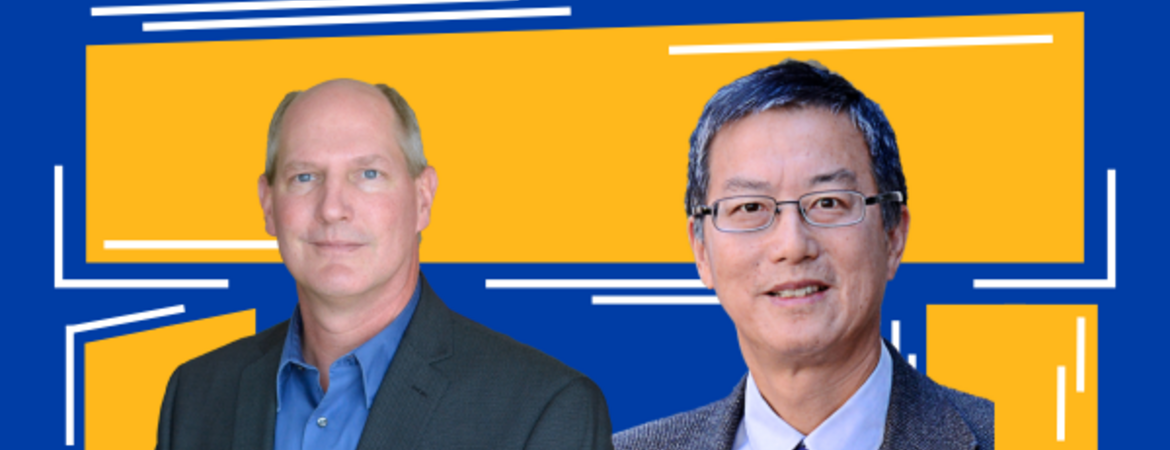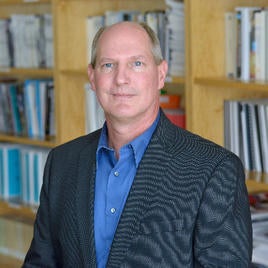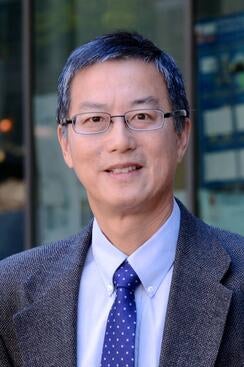
From life-saving medicine to transportation innovation, the work of engineers at UC Riverside’s Bourns College of Engineering (BCOE) inspires students, sparks discovery, and drives solutions to pressing issues of the world today.
Two of those engineers, Matthew Barth and Xiaoping Hu, received appointments on July 1 as the Esther & Daniel Hays and Reza Abbaschian endowed chairs, respectively. The appointments confer prestige along with endowment investment income to expand the professors’ research.
Barth and Hu are the first to hold the new chairs after a competitive application process based on the strength of past and ongoing research, said Chris Lynch, the dean of BCOE. The college has 16 endowed chairs in all.
“They (Barth and Hu) are both outstanding in all respects and have a long record of accomplishments,” Lynch said.
Matthew Barth, from Boulder, Colo., has served UCR since 1992, after earning his Ph.D. in electrical and computer engineering from UC Santa Barbara in 1990. His research centers on applying engineering system concepts and automation technology to transportation systems, with emphases on energy, air quality, and climate issues.
Barth, a professor of electrical and computer engineering and former longtime director of the Center for Environmental Research and Technology (CE-CERT) at UCR, came to study transportation through his graduate-school training in robotics.
“Much of transportation (innovation) comes from the robotics field, including navigation and mobility,” he said. Working at CE-CERT, he also saw a strong need for improving traffic safety, mobility, and air quality in congested Southern California.

Key achievements
For decades, Barth has worked with U.S. and Japanese automakers to develop technologies, including on-board navigation, that support, assist and protect motorists and the environment.
Barth has pioneered eco-routing algorithms that chart the most fuel-efficient driving routes. He has also driven innovation in areas such as:
- Speed harmonization techniques, which use variable speed limits to smooth out traffic and avoid stop-and-go congestion;
- Eco-Friendly Adaptive Cruise Control, which sets a cruising speed while also ensuring a safe distance between a car and the vehicle in front of it; and
- Ramp metering techniques that minimize emissions and help prevent bottlenecks at freeway onramps.
By managing traffic, these approaches help protect human life; save time, fuel and energy; and cut air pollution and greenhouse gases.
What’s next
Barth’s latest research centers on smart intersections, which use cameras and sensors to communicate with cars, preventing accidents and keeping traffic moving at a steady flow.
BCOE has partnered with the city of Riverside to install smart intersection technology at University and Iowa avenues, with plans to roll the pilot project down University through the city’s 6-mile, 10-intersection Innovation Corridor between UCR and downtown.
The system works, for instance, by warning drivers if a truck is blocking the view of a pedestrian, or by sharing stoplight phase and timing information to help motorists optimize driving speeds. Many new cars, especially EVs, have technology to make this possible.
UCR is also one of 15 universities nationwide participating in the EcoCAR EV Challenge, a four-year engineering competition of the U.S. Department of Energy in which teams of college students coordinate to design smart technologies for a 2023 Cadillac LYRIQ EV.
“Being part of EcoCAR makes students very employable,” Barth said. “Automakers and other companies tend to hire them right away.”
On the Hays appointment
“Esther Hays was a big air-quality advocate and longtime supporter of CE-CERT, providing scholarships and meeting with students,” Barth said. “I was proud to receive this appointment, given my 20-year-long relationship with her at CE-CERT. My interaction with her all those years makes this very special.”
On life balance
“My wife and I enjoy hiking and the outdoors. I’m also very involved in Scouting – promoting opportunities for youth such as camping and outdoor activities.”
On success
“Do research on a topic you like, stick to it, and pursue it to a particular goal” such as writing a paper, developing a patent, or piquing student interest. “Also, have patience – do those things consistently.”
Xiaoping Hu, a native of Nanjing, China, received his Ph.D. in medical physics from the University of Chicago in 1988 and has served UCR since 2016. His areas of expertise include magnetic resonance imaging and spectroscopy, functional MRI, image reconstruction and processing, and molecular imaging.

Hu, professor and chair of the Department of Bioengineering and founding director of the Center for Advanced Neuroimaging at UCR, was drawn to science, technology, engineering and math (STEM) classes as a child. Intrigued by semiconductors and the science behind technology, he thought he’d become a physicist. But graduate-school physics projects left him cold: He found them remote and abstract.
“So I searched for a field that would still utilize my physics background and produce things that I could see and be immediately applicable,” Hu said. “I found MRI and never regretted switching to it.”
Key achievements
Hu indeed has brought tangible advances to the field of MRI, which uses tube-like machines with a magnet, radio waves and a computer to create images of internal organs and tissues. Over the years, he has devised techniques that enhance MRIs, improve the diagnosis and treatment of brain disease, and support brain health, function and recovery.
First, Hu pioneered technology to remove unrelated noise and fluctuations – from a person’s heartbeat and respiration – from brain MRI signals. Second, he pioneered methods for MRI scanning, particularly brain scanning at very high magnetic field strengths, to yield better images: “like a picture with more brightness and better contrast in some areas,” he said.
Both advances, now widely used in practice, have handed doctors and scientists better tools to diagnose, understand, and treat brain conditions such as Parkinson’s disease, Alzheimer’s disease, tumors, strokes, depression, and injuries from trauma.
Hu also created a brain atlas that maps the organ based on how different parts of the brain interact and are connected. This tool, used to study the brain’s connectivity and function in normal people or people with brain disorders, has also been broadly adopted.
What’s next
In addition to continuing his studies of Parkinson’s disease and aging, Hu’s current research includes clearing hurdles to using creatine to treat neurogenerative disease. Because creatine cannot readily cross the blood-brain barrier, Hu and his team are exploring delivery by nasal spray, an approach that has shown promise in animal testing.
Nasal delivery of creatine could provide more energy storage in the human brain, perhaps helping people with Alzheimer’s disease, Hu said.
Funding from the Abbaschian endowment will help advance this research.
On the Abbaschian appointment
“First of all, it is a great recognition,” Hu said. “Second, I have a lot of respect for Reza and am very honored to be named this particular chair. I was very elated when I found out.”
The Reza Abbaschian Endowed Professorship honors the former longtime BCOE dean who built the college into a Top 50 engineering school in the nation.
On life balance
“I am an avid badminton player and can still challenge players a third of my age in singles games. I also downhill ski as much as possible in the winter.”
On success
“I think interest in the work you do, thinking out of box, and drawing inspirations from related fields are the most helpful. My favorite quote would be ‘Chances favor the prepared mind.’”